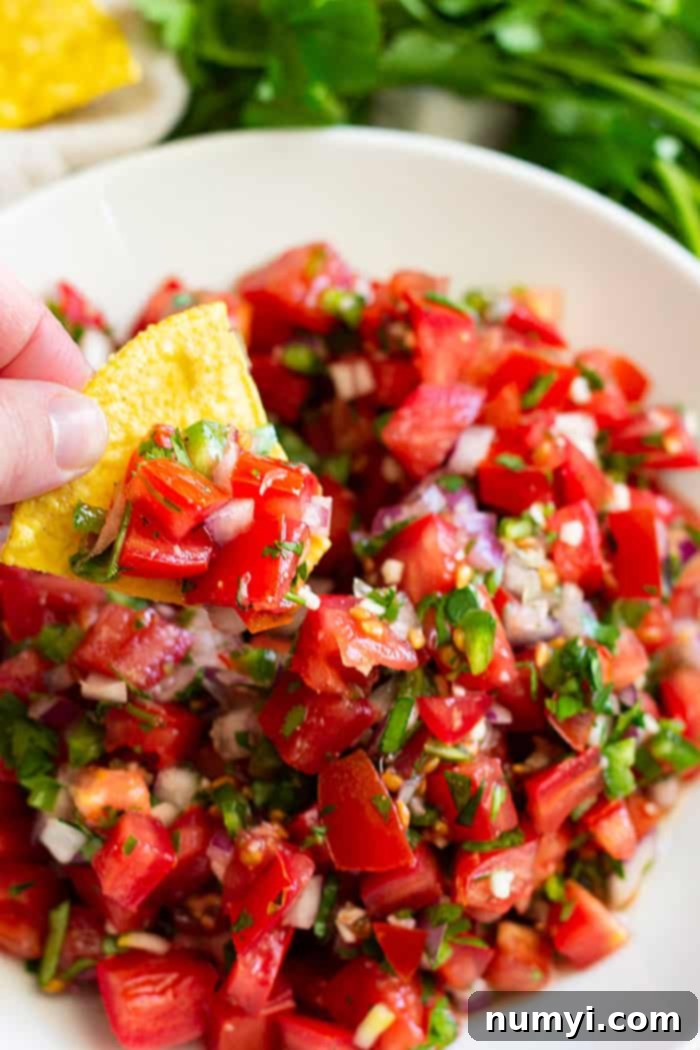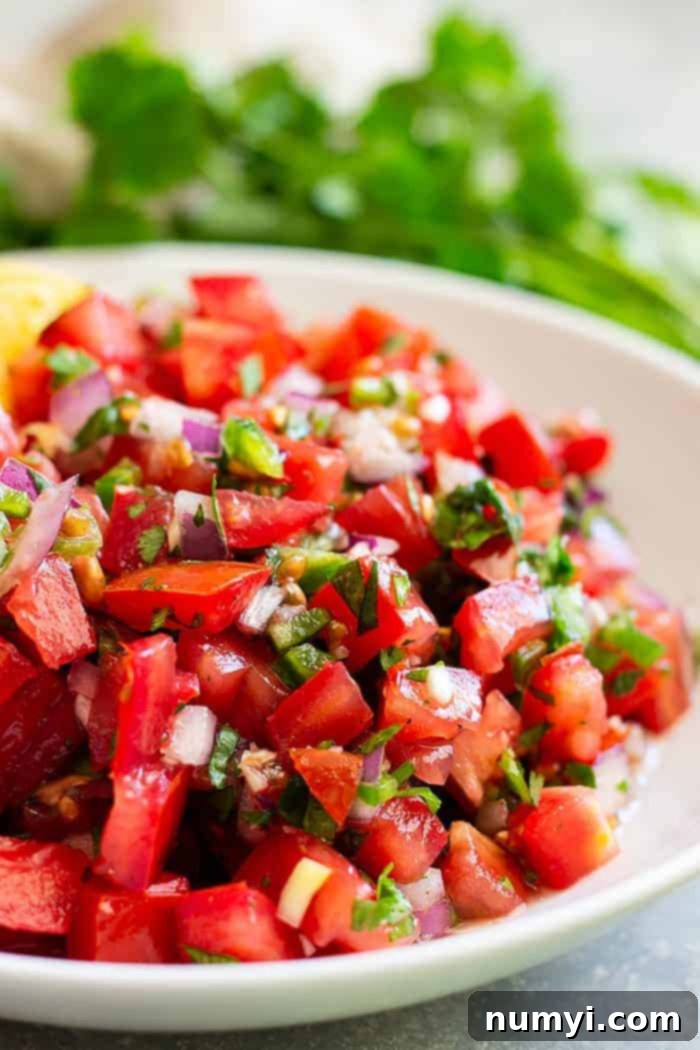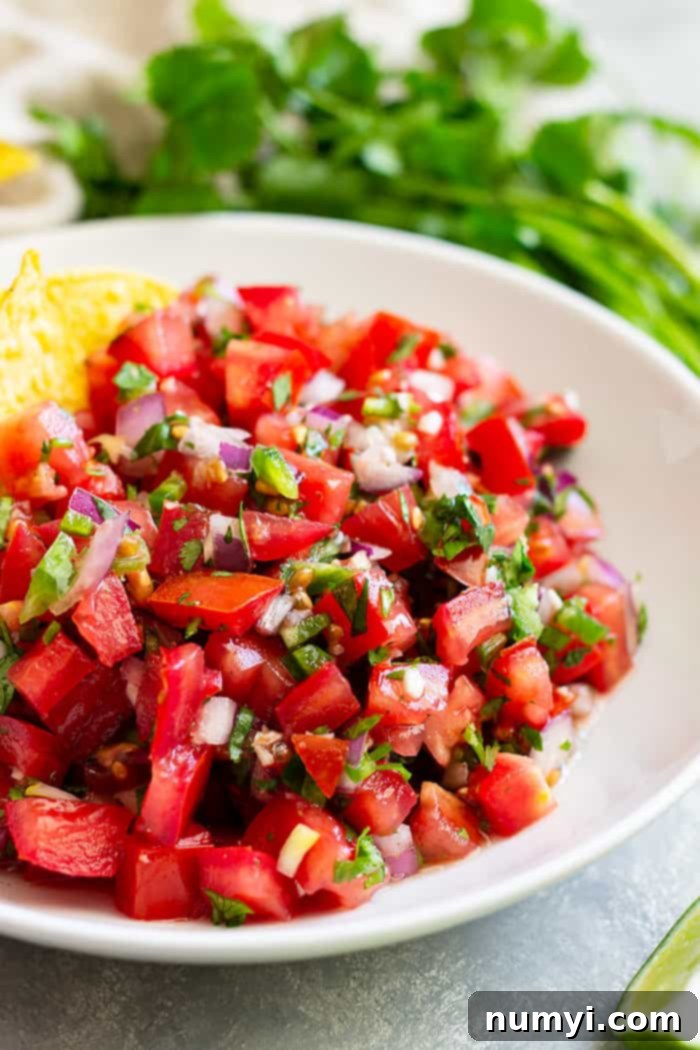Homemade Pico de Gallo: The Ultimate Fresh & Easy Salsa Recipe
There’s an undeniable magic in a truly fresh salsa, and amongst the many varieties, Pico de Gallo shines as a beacon of vibrant simplicity. Often affectionately known as “salsa fresca” or “salsa cruda,” this classic Mexican condiment is a culinary marvel. It combines the wholesome goodness of ripe tomatoes, the crisp bite of onion, the aromatic zest of cilantro, the bright tang of lime juice, and a customizable kick from jalapeño. Far from being an intimidating or complex dish, Pico de Gallo is a testament to how a handful of high-quality, fresh ingredients can come together to create something profoundly delicious and remarkably versatile.
This comprehensive guide is designed to empower you to create the perfect Pico de Gallo right in your own kitchen. We’ll delve into the nuances of selecting the finest produce, mastering the simple art of chopping, and expertly adjusting the spice level to suit your palate. By following our tips and tricks, you’ll be well on your way to crafting a fresh salsa that is not only spectacular in flavor but also a healthy and invigorating addition to countless meals. Prepare to impress your family and friends with this essential, easy-to-make, and incredibly tasty staple.

Why Homemade Pico de Gallo Surpasses Store-Bought Options
The question of why one should dedicate time to preparing Pico de Gallo from scratch, given the abundance of ready-made options, is a valid one. However, the answer is simple and compelling: homemade offers an unparalleled level of freshness, flavor, and control that pre-packaged alternatives simply cannot match. Commercial salsas, while undeniably convenient, frequently fall short in delivering the bright, crisp, and robust flavors inherent in truly fresh ingredients. They often contain stabilizers, preservatives, or artificial flavors that mute the natural vibrancy, resulting in a product that tastes lackluster compared to its homemade counterpart.
When you take the reins and make Pico de Gallo at home, you become the curator of quality. You hand-pick the ripest tomatoes, ensuring optimal sweetness and texture. You select the most fragrant cilantro, guaranteeing that essential herbaceous note. Crucially, you control the balance of flavors and the intensity of the heat, tailoring it precisely to your preference. This degree of customization is a luxury unavailable with mass-produced salsas. Moreover, the preparation process is surprisingly quick and straightforward, making it an ideal candidate for a spontaneous snack, a last-minute party contribution, or a vibrant accompaniment to almost any meal. More than just a recipe, homemade Pico de Gallo is a versatile culinary foundation, effortlessly adaptable and infinitely more satisfying.
On a personal note, I have to admit a particular fondness for enjoying this Pico de Gallo straight from the bowl with just a spoon – it’s genuinely that irresistible! Beyond this guilty pleasure, its versatility makes it an outstanding companion to a multitude of dishes. It’s absolutely delightful with these Bean and Cheese Breakfast Tacos, offers a burst of freshness when dolloped onto Breakfast Enchiladas, and forms a perfect counterpoint to the savory richness of this Slow Cooker Shredded Mexican Chicken. The culinary applications truly are boundless: envision it piled high on tacos, nestled within burritos, enriching quesadillas, transforming nachos, or even brightening your morning eggs. It serves as a refreshing appetizer alongside crispy tortilla chips, or as a vibrant topping for grilled meats and salads. This is truly a ‘back pocket’ recipe you’ll find yourself relying on again and again.


Essential Ingredients and Preparation Tips for a Perfect Pico de Gallo
While the list of ingredients for Pico de Gallo is refreshingly short and simple, the quality and mindful preparation of each component are paramount to achieving an exceptional result. Adhering to these expert recommendations will ensure your homemade fresh salsa bursts with maximum flavor and boasts an inviting texture:
- Tomatoes are Key: The foundation of any great Pico de Gallo lies in its tomatoes. Seek out nice, ripe Roma tomatoes, which are typically preferred due to their firm, meaty flesh and relatively low water content. A truly ripe tomato will display a deep red color and emit a distinct, sweet, earthy aroma. If a tomato lacks fragrance, it will likely contribute minimal flavor to your salsa. While Romas are ideal, other firm, flavorful varieties like beefsteak or even cherry tomatoes (halved or quartered) can be excellent substitutes if perfectly ripe.
- The Power of Fresh Lime Juice: This is a non-negotiable step: ditch the bottled lime juice entirely! Only freshly squeezed lime juice will provide the bright, acidic, and complex tang that is vital for balancing and enhancing all the other flavors in Pico de Gallo. It acts as a natural “cooking” agent, subtly mellowing the raw onion and garlic while elevating the freshness of the entire mixture. Invest the extra minute or two – it truly makes a world of difference.
- Don’t Underestimate Salt: Salt in Pico de Gallo serves a dual purpose beyond mere seasoning. Firstly, it amplifies and brightens the natural flavors of the vegetables. Secondly, as the Pico de Gallo rests, the salt gently draws out moisture and deeper flavors from the tomatoes. Crucially, it also works to mellow and temper the sharp, pungent notes of the raw onion and garlic, integrating them more harmoniously into the overall flavor profile. Begin with a measured amount and then incrementally add more, tasting frequently until you achieve the perfect balance.
- Mastering Your Heat Level: Pico de Gallo offers complete control over its spiciness. For a milder salsa, diligently remove all the white ribs and seeds from the jalapeño, as these are the primary carriers of capsaicin, the compound responsible for heat. If you crave more intensity, feel free to leave some or all of the ribs and seeds intact. For those who enjoy a significant kick, consider incorporating a hotter pepper like a serrano, or even a small dash of your favorite hot sauce or a pinch of cayenne pepper. Always remember to wear gloves when handling hot peppers to prevent skin irritation.
- Crafting Your Ideal Texture: The hallmark of traditional Pico de Gallo is its wonderfully chunky texture, where each ingredient retains its individual character. To achieve this, dedicate time to finely dicing all your ingredients by hand, ensuring consistent small pieces. However, if your preference leans towards a slightly smoother consistency – perhaps a texture somewhere between chunky Pico and a blended salsa – your food processor can be a valuable tool. Simply cut your tomatoes, onions, and peppers into larger chunks, place them in the food processor, and pulse cautiously. The key is to pulse in short bursts until you reach your desired consistency, being vigilant not to over-process, which can quickly lead to a watery, mushy result. Regardless of method, always season generously with salt after chopping or processing.
- Fresh Garlic and Cilantro: Use fresh garlic, not powdered. Mince it finely so it blends well. For cilantro, ensure it’s fresh and vibrant. Wash it thoroughly and chop it just before adding to retain its bright, herbaceous flavor.

Pico de Gallo vs. Traditional Salsa: Understanding the Distinction
It’s common for the terms “Pico de Gallo” and “salsa” to be used interchangeably, but there’s a clear and important difference between these two staples of Mexican cuisine. Appreciating this distinction can deepen your understanding and enjoyment of both. The fundamental difference lies in their preparation, texture, and often, their primary ingredients:
- Pico de Gallo (Salsa Fresca / Salsa Cruda): As the name “salsa fresca” (fresh sauce) or “salsa cruda” (raw sauce) suggests, Pico de Gallo is made exclusively with uncooked, raw ingredients. It is characterized by its chunky texture, where each individual component – the diced tomatoes, onions, cilantro, and peppers – remains distinct and visible. It contains minimal liquid, usually just the natural juices from the vegetables and lime. Pico de Gallo is designed to be eaten immediately or very soon after preparation, celebrating the pure, vibrant, and crisp flavors of the fresh produce. Its “salad-like” consistency makes it an excellent topping or scoopable dip.
- Traditional Salsa (Salsa Roja / Salsa Verde, etc.): This broader category typically refers to salsas that are blended or puréed, often utilizing cooked or canned tomatoes (or tomatillos for salsa verde). The ingredients are no longer distinct chunks but rather form a more uniform, often smoother consistency. Traditional salsas tend to have more liquid than Pico de Gallo. They can be cooked, such as a roasted tomato salsa where ingredients are charred and then blended, or made from fresh ingredients that are subsequently blended until smooth. The blending and potential cooking processes often result in a deeper, more harmoniously melded flavor profile, where individual components are less pronounced. These salsas are frequently used as a base for cooking, as a dipping sauce, or as a condiment.
In essence, while Pico de Gallo is indeed a type of salsa, it is a specific style defined by its raw, chunky, and fresh characteristics. Not all salsas are Pico de Gallo, but Pico de Gallo is always a fresh salsa.
Can I Freeze Homemade Pico de Gallo?
While technically possible, it’s crucial to manage expectations regarding freezing homemade Pico de Gallo. Yes, you can freeze it, but be aware that its texture will undergo a significant change upon thawing. The high water content within the tomatoes and other vegetables expands during freezing, causing their cell walls to rupture. This process inevitably leads to a much softer, often mushier, and more watery consistency once thawed, losing the desirable crispness and chunky nature that defines fresh Pico de Gallo. While the texture may no longer be ideal for serving as a fresh dip with chips or as a chunky topping, rest assured that the flavor will largely remain intact and still be delicious!
If you intend to freeze your Pico de Gallo, we recommend draining any excess juice before transferring it to an airtight, freezer-safe container or heavy-duty freezer bag. It can be stored in the freezer for up to 3 months. Upon thawing, it’s best utilized in applications where the texture is less critical. Consider blending it into a smoother sauce for enchiladas, incorporating it into chili, soups, or stews, or mixing it directly into ground meat for tacos, burritos, or casseroles. Blending the thawed Pico de Gallo can also help to create a more uniform consistency if you prefer it less chunky for certain recipes.
How to Use Homemade Pico De Gallo: Endless Possibilities
The remarkable versatility of fresh homemade Pico de Gallo means it can effortlessly enhance almost any meal or snack. Its bright, fresh flavors and satisfying texture make it an indispensable ingredient in a wide array of culinary contexts. Here are just a few of my favorite ways to incorporate it:
- The Quintessential Chip Dip: This is the obvious, yet always satisfying, choice! Serve it generously with your favorite crunchy tortilla chips for an unbeatable appetizer or casual snack.
- Breakfast Elevated: Transform your morning meal! Spoon a dollop over scrambled, fried, or poached eggs, or fold it into an omelet or breakfast burrito for an invigorating burst of fresh flavor and color.
- Mexican Fiesta Foundation: Pico de Gallo is an absolute essential for building authentic Mexican-inspired dishes. Pile it high on tacos, stuff it into burritos, spoon it over enchiladas, sprinkle it onto quesadillas, or load it onto nachos for a crucial element of freshness, acidity, and satisfying crunch.
- Grilled Protein Perfection: A generous spoonful over simply grilled chicken, flaky fish (like cod or tilapia), or a juicy steak, especially when seasoned with a little taco or fajita seasoning, instantly elevates a basic protein into a vibrant, restaurant-quality meal.
- Salad and Grain Bowl Booster: Incorporate it into your favorite green salads or use it as a refreshing topping for grain bowls, adding a lively dimension of flavor, moisture, and delightful texture.
- Avocado Toast Upgrade: Take your avocado toast to the next level by spreading a layer of Pico de Gallo over the creamy avocado for a quick, healthy, and incredibly flavorful breakfast or lunch.
- Soup and Chili Swirl: Stir a tablespoon or two into a bowl of hearty chili, black bean soup, or tortilla soup just before serving. It introduces a fresh counterpoint to rich, savory broths and adds a beautiful pop of color.
- Pizza Topping Twist: For an unconventional but delicious twist, use it as a fresh topping on a Mexican-inspired pizza or flatbread after baking.
- My Personal Favorite Indulgence: If you’re anything like me, sometimes the purest enjoyment comes from simply savoring it straight out of the bowl with a spoon. No judgment here – it’s just that good!
Truly, this is a phenomenal “back pocket” recipe to master and keep readily available. Its ease of preparation, adaptability, and universal appeal will make it a staple you’ll find yourself turning to time and time again. I genuinely hope you thoroughly enjoy the process of making and, more importantly, devouring this fresh, vibrant, and utterly delicious Homemade Pico de Gallo!

Homemade Pico de Gallo Recipe
Homemade Pico de Gallo Recipe – a quick and easy fresh salsa recipe using simple ingredients. Easy to make as chunky as you like or as spicy or mild as you like.

Print Recipe
Ingredients
- 5 large Roma tomatoes, diced
- 1/2 cup diced red onion
- 1/2 cup fresh cilantro, chopped
- 1 jalapeño, ribs and seeds removed for mild (or leave some for heat), finely chopped
- 1 large clove garlic, minced
- Juice of 1 fresh lime (approximately 2 tablespoons)
- Salt to taste
Instructions
- In a medium-sized bowl, gently combine all the diced ingredients: Roma tomatoes, red onion, chopped cilantro, finely chopped jalapeño, and minced garlic.
- Pour in the fresh lime juice and stir everything together thoroughly.
- Season the mixture generously with salt, starting with about 1/2 teaspoon. Taste and add more salt incrementally until the flavors are perfectly balanced to your preference.
- For optimal flavor development, allow the Pico de Gallo to sit at room temperature for at least 20 minutes before serving. This resting period is crucial for the flavors to meld beautifully and for the salt to draw out even more delicious juices from the tomatoes, while also mellowing the sharpness of the raw onion and garlic.
- Give it one final stir and a taste-test before serving to ensure seasoning is perfect. Enjoy your incredibly fresh homemade Pico de Gallo!
Notes
- Tomato Quality: Always prioritize ripe, fragrant, deep-red Roma tomatoes for the best flavor foundation.
- Freshness is Key: Bottled lime juice is not a substitute for fresh. Use freshly squeezed lime juice for vibrant acidity.
- Salt’s Role: Don’t under-salt! It balances and enhances flavors, and mellows raw garlic and onion. Season to taste.
- Heat Customization: Remove jalapeño ribs/seeds for mild; leave them for more heat. Consider serrano peppers for extra spice.
- Texture Preference: Dice by hand for chunky. For a smoother consistency, pulse large chunks in a food processor, being careful not to over-process.
- Freezing Guidelines: Drain excess liquid before freezing for up to 3 months. Note that freezing alters texture, making it softer, so it’s best for cooked dishes after thawing.
- Storage: Store leftovers in an airtight container in the refrigerator for up to 5-7 days for best freshness.
Did you make this?
Let me know by sharing a picture and tagging @countryside_cravings on Instagram
